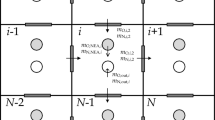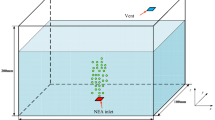Abstract
Fuel scrubbing technology could be used for fuel tank inerting and fuel deoxygenation. Both N2 and CO2 are perfect inert gases, but the solubility of CO2 is nearly 20 times higher than that of N2 in jet fuels, so the scrubbing inerting process varies with the selection of N2 or CO2. A scrubbing test bench is constructed, and the variation of oxygen concentration on ullage or in the fuel is measured under various flow rates, fuel loads and initial oxygen concentrations on ullage. Experimental results reveal that the ullage and dissolved oxygen concentrations of CO2 scrubbing are always higher than that of N2 scrubbing. The inerting time of CO2 scrubbing of a 30%, 50% and 70% fuel load is approximately 1.42, 1.7 and 2.75 times that of N2 scrubbing, respectively. The scrubbing test under 5%, 9% and 14% initial ullage oxygen concentration revels a peak in ullage oxygen concentration of 7.23% and 9.97% for N2 scrubbing and that of 12.63%, 13.4% and 15.4% for CO2 scrubbing, respectively.










Similar content being viewed by others
References
Gann RG (2008) Guidance for advanced fire suppression in aircraft. Fire Technol 44(3): 263–282. https://doi.org/10.1007/s10694-007-0026-4
Aviation Rulemaking Advisory Committee (ARAC) (1998) Fuel tank harmonization working group. Final report. https://www.fire.tc.faa.gov/pdf/EXECSUM.pdf
Department of Transportation, Federal Aviation Administration (2008) Reduction of fuel tank flammability in transport category airplanes. Final Rule. http://www.gao.gov/assets/90/85364.pdf
Federal Aviation Administration (2008) Fuel tank flammability reduction means. Advisory Circular No. 25.981-2A. https://www.fire.tc.faa.gov/pdf/systems/AC_25.981-2A.pdf
Paul BS and Ernest SS (1955) Inerting conditions for aircraft fuel tanks. WADC technical report 55-418. https://www.fire.tc.faa.gov/pdf/systems/WADC_TR_55_418.pdf
Anderson CL (1978) Test and evaluation of Halon 1301 and nitrogen inerting against 23MM HEI. AFFDL-78-66. https://www.fire.tc.faa.gov/pdf/systems/AFFDL_TR_78_66.pdf
Charles MP, Thomas H (1980) A study of the blast and combustion over-pressure characteristics of the 23MM high explosive incendiary-tracer (HEI-T). https://www.fire.tc.faa.gov/pdf/systems/NWC_TP_7129.pdf
Atallah S, Buccigross HL (1971) Development of halogenated hydrocarbon foam (halofoam) extinguishants. Fire Technol 7(4): 307–320. https://doi.org/10.1007/BF02590321
Klueg EP (1969) Liquid nitrogen as a powerplant fire extinguishant. Fire Technol 5(3): 197–202. https://doi.org/10.1007/BF02591516
Geffs T (1969) Fuel tank inerting and fire fighting with liquid nitrogen. Fire Technol 5(3): 193–196. https://doi.org/10.1007/BF02591515
Hirst R, Booth K (1977) Measurement of flame-extinguishing concentrations. Fire Technol 13(4): 296–315. https://doi.org/10.1007/s10694-007-0026-4
Wang J, Lu S, Hu Y et al (2015) Early stage of elevated fires in an aircraft cargo compartment: a full scale experimental investigation. Fire Technol 51(5): 1129–1147. https://doi.org/10.1007/s10694-015-0475-0
Cavage WM (2000) The cost of implementing ground-based fuel tank inerting in the commercial fleet. FAA report DOT/FAA/AR-00/19. https://www.fire.tc.faa.gov/pdf/00-19.pdf
Aviation Rulemaking Advisory Committee (ARAC) (1998) Fuel tank harmonization working group. Task Group 3. https://www.fire.tc.faa.gov/pdf/TG3.pdf
McConnell PM, Dalan GA, Anderson CL (1986) Vulnerability methodology and protective measures for aircraft fire and explosion hazards, volume III, on-board inert gas generator system (OBIGGS) studies part 2 fuel scrubbing and oxygen evolution tests. AD-A167445. http://www.dtic.mil/get-tr-doc/pdf?Location=U2&doc=GetTRDoc.pdf&AD=ADA167445
Grenich AF, Tolle FF, Glenn GS et al (1984) Design of on-board inert gas generation systems for military aircraft. AIAA/AHS/ASEE Aircraft Design Systems and Operations Meeting. https://doi.org/10.2514/6.1984-2518
Burns M, Cavage WM, Morrison R et al (2004) Evaluation of fuel tank flammability and the FAA inerting system on the NASA 747 SCA. FAA report DOT/FAA/AR-04/41. https://www.fire.tc.faa.gov/pdf/04-41.pdf
Burns M, Cavage WM (2003) Flight-testing of the FAA onboard inert gas generation system on an airbus A320. FAA Report DOT/FAA/AR-03/58. https://www.fire.tc.faa.gov/pdf/03-58.pdf
Spadaccini LJ, Sobel DR, Huang H (1999) Deposit formation and mitigation in aircraft fuels. The International Gas Turbine and Aeroengine Congress & Exhibition, Indianapolis, IN
Spadaccini LJ, Huang H (2002) On-line fuel deoxygenation for coke suppression. In: Proceedings of ASME Turbo Expo 2002, Amsterdam
Pei XY, Hou LY (2016) Effect of dissolved oxygen concentration on coke deposition of kerosene. Fuel Process Technol 142:86–91. https://doi.org/10.1016/j.fuproc.2015.09.029
Morris RW, Miller J, Limaye SY (2006) Fuel deoxygenation and aircraft thermal management. In: AIAA 4th international energy conversion engineering conference and exhibit (IECEC), San Diego, CA
Johnson RW, Michalakos PM, Blumer E et al (2017) Fuel deoxygenation and fuel tank inerting system and method. United States Patent, Patent No: US 9,687,773 B2
Lawson CP, Lim KM (2008) The state-of-the-art and the future of water management within fuel tanks. In: 26th international congress of the aeronautical sciences, Anchorage
Wetterwald M, Lawson CP, Lam JKW (2010) Feasibility study of OBIGGS for water contamination control in aircraft fuel tanks. In: 10th AIAA aviation technology, integration, and operations (ATIO) conference, Fort Worth, TX
Merkulov O, Zherebtsov V, Peganova M (2011) OBIGGS for fuel system water management proof of concept. SAE Int J Aerosp 4(2):1465–1474. https://doi.org/10.4271/2011-01-2793
Walker S, Jung W, Robertson S (2013) Demonstration of a novel catalyst based green on board inert gas generation system (GOBIGGS™) for fuel tank inerting. The AHS 69th annual forum, Phoenix, Arizona.
Limaye SY, Robertson S, Koenig D et al (2007) Development of a“Green” on-board inert gas generation system. In: Proceedings of the 15th triennial international fire and cabin safety research conference, New Jersey.
Coordinating Research Council. Handbook of Aviation Fuel Properties, CRC Report No. 635, Dec. 2004
American Society for Testing and Materials (2002) Standard test method for estimation of solubility of gases in petroleum liquids, ASTM D2779-92
Birdi KS, Kleinitz W (1998) Problems associated with dissolved atmospheric oxygen in crude oil at production facilities. OIL GAS-EUR MAG 24(2):25–28.
Cai Y, Bu X, Lin G et al (2015) Experimental study of an aircraft fuel tank inerting system. Chin J Aeronaut 28(2):394–402. https://doi.org/10.1016/j.cja.2015.02.002
Burns M, Cavage WM (2001) Inerting of a vented aircraft fuel tank test article with nitrogen-enriched air. FAA report DOT/FAA/AR-01/6. https://www.fire.tc.faa.gov/pdf/01-6.pdf
Acknowledgements
This work was supported by Funding of Jiangsu Innovation Program for Graduate Education (KYLX15_0231), Postgraduate Research & Practice Innovation Program of Jiangsu Province (KYCX17_0279), the Fundamental Research Funds for the Central Universities, Aviation Industry Corporation of China Technology Innovation Fund for Fundamental Research (2014D60931R), and Funding of Ministry of Industry and Information Technology for Civil Aircraft.
Author information
Authors and Affiliations
Corresponding author
Rights and permissions
About this article
Cite this article
Shao, L., Liu, W., Li, C. et al. Experimental Comparison of Fuel Scrubbing Inerting Process Using Nitrogen and Carbon Dioxide of Aircraft Fuel Tanks. Fire Technol 54, 379–394 (2018). https://doi.org/10.1007/s10694-017-0688-5
Received:
Accepted:
Published:
Issue Date:
DOI: https://doi.org/10.1007/s10694-017-0688-5




